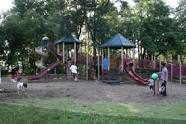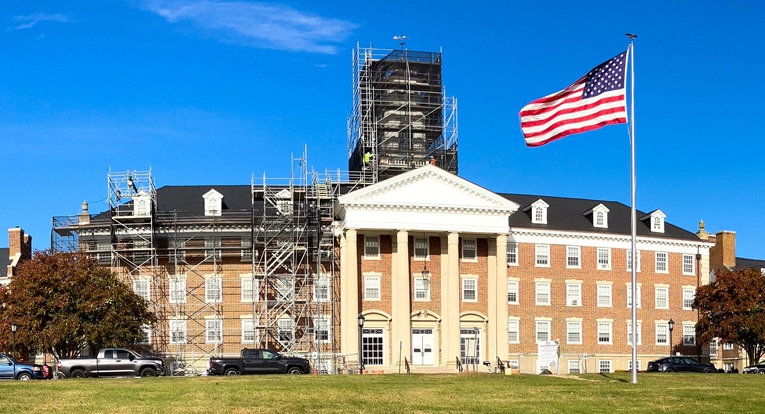So many factors come into play with decisions on replacing surfaces and equipment on playgrounds in the 21st century that it is difficult to establish simple rules for what should be done, especially when funding is limited. On January 13 the Greenbelt City Council held a worksession to discuss what type of surfacing to use during the next renovation of the playground at 1 Court Southway. The discussion expanded to include priorities for other playgrounds covered under the city’s maintenance agreement with Greenbelt Homes, Inc. (GHI) and other participating homeowners associations (HOAs).
Although decisions are not made at council worksessions, strong feelings were expressed among most councilmembers that available funding should be targeted at removing the shredded rubber mulch (also called chunk rubber) currently still in use as the surfacing material for nine city playgrounds. Of those, only the playground at 1 Court Southway is owned by the city. Of the remaining eight, six are located in Greenbelt East (one at Greenwood Village, five at Windsor Green) and two are owned by GHI.
With a touch of understatement, Mayor Emmett Jordan started the meeting by saying the general topic of playground resurfacing has taken up a good deal of staff time and has been touched upon at a number of city council meetings and worksessions. Study and recommendations have also been undertaken by the Park and Recreation Advisory Board (PRAB).
Safety Concerns
The immediate issue is safety concerns with the shredded rubber mulch. Jordan reported that although $76,000 has been budgeted for this year to remove the shredded rubber and resurface the playground at 1 Court Southway, councilmembers have been divided in their opinions on how to proceed. Jordan asked Assistant City Manager David Moran, who has handled most of the staff work on this project, to give an overview of the options.
Moran said that, besides the shredded rubber mulch, the two options for surfacing are engineered wood fiber (EWF) and the “poured in place” (PIP) solid surface.
For the playground at 1 Court Southway, staff recommended EWF, primarily because equipment on that playground is not yet due for replacement. Replacing equipment is a much bigger undertaking with PIP than with wood fiber.
Jordan asked if there is enough money budgeted to replace the equipment at this playground now and to do the PIP surface. Moran said there is not, since replacing the necessary equipment would cost another $30,000.
The two types of surfacing (EWF and PIP) differ in many ways, and Jordan and Moran ran through the litany of pros and cons. PIP is more durable, possibly lasting up to 20 years and requiring little maintenance. Although it is thought likely to be the best long-term investment, it is substantially more expensive up front and can reach alarmingly high temperatures when exposed to sunlight on hot days.
Cheaper Surface
The EWF surface is cheaper and, while it can also become hot, it does not reach the temperatures of PIP. On the other hand, it requires considerable additional maintenance, in the form of raking and turning it over, to keep it from settling and having less “bounce” and also to keep it from developing fungus. According to Moran, the critical factor in judging how long a surfacing product will last is its bounce or “absorbing impact” factor, since that is what protects children from the impact of serious falls.
Councilmember Silke Pope spoke in strong support of using PIP because of its safety in protecting children from injuries. She was also concerned with the level of maintenance required to keep the wood fiber in good shape.
City Manager Michael McLaughlin replied that it is true that the city needs to do – and intends to do – a better job with the maintenance than it has in the past. Pope suggested that an alternate plan would be to use EWF now and wait to install the PIP when the time comes to replace the equipment.
Councilmember Judith Davis encouraged taking a survey of residents who use this playground to see if they have strong preferences. She also asked whether there had been earlier council direction to not install any EWF until additional staff had been hired in Public Works to assure keeping up with necessary maintenance.
Remove Mulch
Councilmember Rodney Roberts said the top priority should be to remove the rubber mulch on playgrounds that still have it in Greenbelt East. He did not think it was justifiable to spend additional money on PIP surfacing until the rubber mulch had been removed.
Councilmember Leta Mach said she would continue to support PRAB’s two recommendations: to use different surfaces on different playgrounds so that residents will have a choice and to use PIP on playgrounds in shady areas and EWF in sunny areas to get the best use of the two substances. Since the Southway playground is shady, PIP would be the preferred surface. Mach added that it would be a waste of money to put EWF there rather than looking at the longer-term investment.
Councilmember Edward Putens agreed with Roberts that removing the rubber mulch should be the top priority. Councilmember Konrad Herling reminded everyone that the issue of installing PIP at a time when equipment needed to be replaced should also be kept in mind as part of this tricky equation.
The mayor agreed that it was a complex issue that required comparing apples and oranges. Risk management, he said, argues for PIP as the safest surface in terms of injuries to children, but since the rubber mulch is thought to be most toxic, EWF may be a preferred shorter-term choice.
Moran added that it was complex and that a confounding factor is that playground safety is a moving target. The city is in charge of 36 playgrounds on a revolving maintenance schedule. As soon as the city decides to do one thing about equipment and materials, safety standards may change, requiring it to consider moving to another alternative.
Yet another complication arose when Pope asked if staff had gotten any response to a survey council had previously requested of the relevant HOAs for their concerns, if any. Moran said there had been little response. He described the format of the survey as limited to whether their residents had raised concerns about shredded rubber and at what point cost-sharing would be available to start maintenance work.
Putens immediately responded that he did not think the HOAs should have to contribute to the replacement of the rubber mulch since it had been the city’s decision to install it. Herling and Roberts agreed that the city should be accountable and remove it. No one questioned that it had been a reasonable decision given all that was known at the time.
Derek Thompson, chair of the Windsor Green HOA, commented that no one in Windsor Green had ever complained about rubber mulch. He pointed out that it would be difficult to survey people’s opinions on the issue without first educating them about it. Roberts agreed, adding that “asking preference without education is meaningless.”
Windsor Green
Thompson went on to inform council that Windsor Green is going to build its own playground near its community center and is asking respondents to its request for proposals to address the subject of playground surfaces.
Also in the audience was Dr. Laura Kressler, a veterinarian and chair of the city’s Public Safety Advisory Committee (PSAC). She reported that the U.S. Food and Drug Administration has recently reissued its opinion on the use of chunk rubber and now expresses significant concern regarding possible toxicity. She added that there is not only the issue of its emitting fumes but also that, unlike a solid surface, it migrates in the environment: for example, rubbing off on clothing and shoes, being put into children’s pockets and being tossed into the air.
Kressler said she personally would support the plan to stretch whatever funds are available to get rid of as much of the rubber mulch as possible and use either EWF or PIP in its place. She added that she thought the members of the PSAC would likely agree.
Modifying a suggestion made earlier by Pope, Davis proposed that the city place priority on removing the shredded rubber and when the time comes to replace the equipment at a playground, to decide whether to install PIP or to continue with EWF.
Although there did not appear to be consensus on whether use of the more expensive PIP should be delayed indefinitely while funds were concentrated on removing the rubber mulch from the remaining playgrounds, there appeared to be majority agreement to replace the shredded rubber with EWF at 1 Court Southway, the first of the playgrounds in question.
A motion to that effect was adopted on the consent agenda of the regular council meeting rescheduled due to snow from January 25 to January 28. The city will likely undertake this work in the early spring, weather permitting. The motion also directed city staff to follow up with Windsor Green, Greenwood Village and GHI regarding replacement of the shredded rubber surfacing located in those playgrounds.




